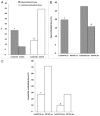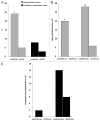Methylation loss at H19 imprinted gene correlates with methylenetetrahydrofolate reductase gene promoter hypermethylation in semen samples from infertile males
- PMID: 23975186
- PMCID: PMC3883776
- DOI: 10.4161/epi.25798
Methylation loss at H19 imprinted gene correlates with methylenetetrahydrofolate reductase gene promoter hypermethylation in semen samples from infertile males
Abstract
Aberrant methylation at the H19 paternal imprinted gene has been identified in different cohorts of infertile males. The causes of H19 methylation errors are poorly understood. In this study, we investigated the methylation status of the H19 gene in semen DNA samples from infertile males affected by MTHFR gene promoter hypermethylation. DNA from normal and abnormal semen samples harbouring MTHFR gene promoter hypermethylated, hmMTHFR-nor and hmMTHFR-abn, and without MTHFR methylation, MTHFR-nor and MTHFR-abn, were investigated for methylation status in the H19 locus using bisulfite-treated DNA PCR, followed by cloning and sequencing. The prevalence of H19 hypomethylated clones was 20% in hmMTHFR-nor and 0% in MTHFR-nor semen samples (p<0.05), and 28% in hmMTHFR-abn compared with 16% in MTHFR-abn semen samples (p>0.05). These results underscore the association between H19 methylation defects and hypermethylation of the MTHFR gene promoter in normal semen samples and suggest that aberrant methylation at H19 may occur in the normal sperm of infertile males affected by MTHFR gene dysfunction. These findings provide new insights into the mechanisms causing abnormal methylation in imprinted genes and, in turn, male infertility.
Keywords: DNA methylation; genetic imprinting; male infertility; spermatozoa.
Figures




Similar articles
-
Methylenetetrahydrofolate reductase gene promoter hypermethylation in semen samples of infertile couples correlates with recurrent spontaneous abortion.Hum Reprod. 2012 Dec;27(12):3632-8. doi: 10.1093/humrep/des319. Epub 2012 Sep 25. Hum Reprod. 2012. PMID: 23010533
-
Sperm DNA integrity status is associated with DNA methylation signatures of imprinted genes and non-imprinted genes.J Assist Reprod Genet. 2021 Aug;38(8):2041-2048. doi: 10.1007/s10815-021-02157-6. Epub 2021 Mar 30. J Assist Reprod Genet. 2021. PMID: 33786731 Free PMC article.
-
Idiopathic male infertility is strongly associated with aberrant promoter methylation of methylenetetrahydrofolate reductase (MTHFR).PLoS One. 2010 Nov 9;5(11):e13884. doi: 10.1371/journal.pone.0013884. PLoS One. 2010. PMID: 21085488 Free PMC article.
-
Impairment of sperm DNA methylation in male infertility: a meta-analytic study.Andrology. 2017 Jul;5(4):695-703. doi: 10.1111/andr.12379. Andrology. 2017. PMID: 28718528 Review.
-
A comprehensive insight into the contribution of epigenetics in male infertility; focusing on immunological modifications.J Reprod Immunol. 2024 Aug;164:104274. doi: 10.1016/j.jri.2024.104274. Epub 2024 Jun 4. J Reprod Immunol. 2024. PMID: 38865894 Review.
Cited by
-
Diabetic Retinopathy: Are lncRNAs New Molecular Players and Targets?Antioxidants (Basel). 2022 Oct 12;11(10):2021. doi: 10.3390/antiox11102021. Antioxidants (Basel). 2022. PMID: 36290744 Free PMC article. Review.
-
MicroRNAs Modulate Signaling Pathways in Osteogenic Differentiation of Mesenchymal Stem Cells.Int J Mol Sci. 2021 Feb 27;22(5):2362. doi: 10.3390/ijms22052362. Int J Mol Sci. 2021. PMID: 33673409 Free PMC article. Review.
-
Regulatory mechanisms of circular RNAs during human mesenchymal stem cell osteogenic differentiation.Theranostics. 2024 Jan 1;14(1):143-158. doi: 10.7150/thno.89066. eCollection 2024. Theranostics. 2024. PMID: 38164139 Free PMC article. Review.
-
Long noncoding RNA KCNMA1-AS2 regulates the function of colorectal cancer cells and sponges miR-1227-5p.BMC Cancer. 2024 Jul 18;24(1):857. doi: 10.1186/s12885-024-12608-9. BMC Cancer. 2024. PMID: 39026221 Free PMC article.
-
Genetics and Epigenetics of Bone Remodeling and Metabolic Bone Diseases.Int J Mol Sci. 2022 Jan 28;23(3):1500. doi: 10.3390/ijms23031500. Int J Mol Sci. 2022. PMID: 35163424 Free PMC article. Review.
References
-
- Diplas AI, Lambertini L, Lee MJ, Sperling R, Lee YL, Wetmur J, et al. Differential expression of imprinted genes in normal and IUGR human placentas. Epigenetics. 2009;4:235–40. - PubMed
Publication types
MeSH terms
Substances
LinkOut - more resources
Full Text Sources
Other Literature Sources
Medical
